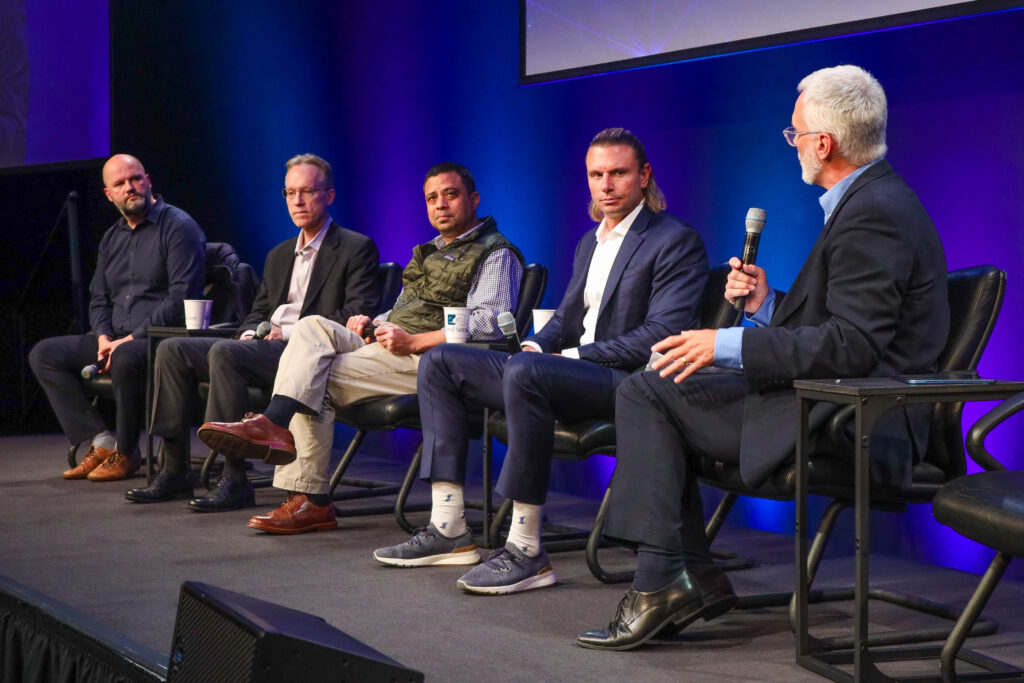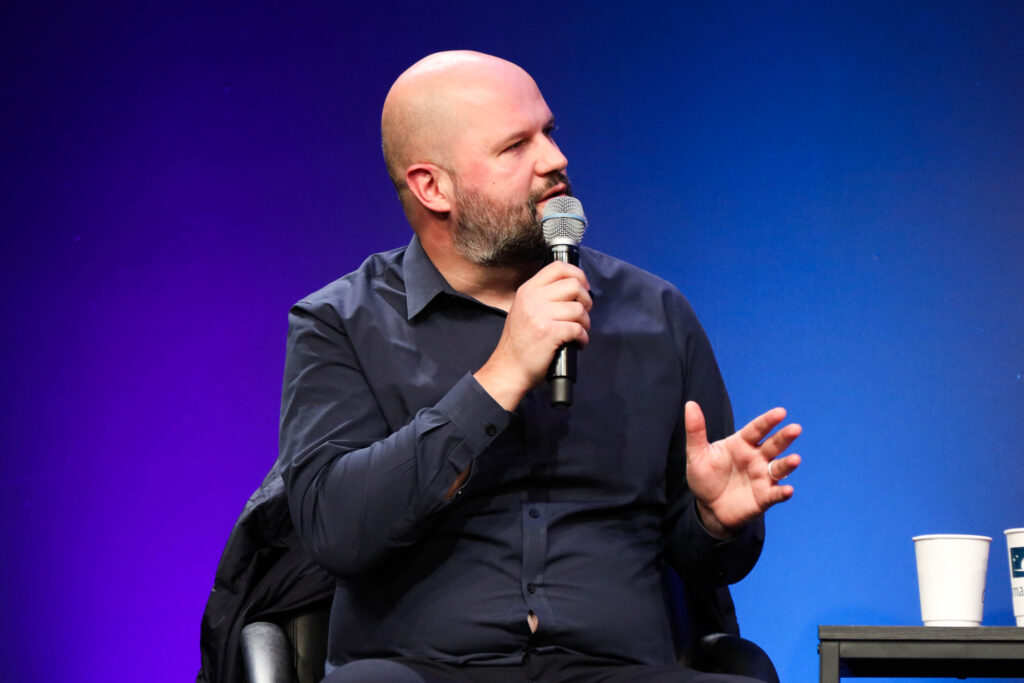By Chris Forrester

Dr Tim Farrar, president of TMF Associates, moderated the popular Direct-To-Devices session at the Silicon Valley Space Week held at Mountain View on October 28. The popularity of the panel, part of the SVSW’s Satellite Innovation segment, and echoed plenty of comments about space-based telecoms already heard by delegates throughout the day. Chris Forrester reports.
However, there remains considerable uncertainty over D2D. Some D2D operators are working with telcos as partners, others are talking about going direct to the user, some are using MSS, others are tapping into the Supplemental Coverage from Space options. Others will concentrate on specific regions or services. Which might succeed? Potential end-users might see D2D as a very exciting time, but the satellite industry and would-be D2D operators need to get many ducks in a row and speedily, if they are to be successful. And that’s without mentioning which handset manufacturers will assist in the operator’s schemes.
There’s also the price versus expectation conundrum. Stuck in the middle of nowhere and a user might happily pay for satellite connectivity as an add-on to their terrestrial phone plan, but if that was a once-only experience would that consumer be prepared to pay extra on a near-permanent basis? For satellite operators to consider a potential of many millions and perhaps billions in terms of a Total Addressable Market was an exciting prospect. And to what extent did vehicles figure in the overall plan, and whether connectivity would be just for safety-based security or for consumer-based services such as built-in entertainment?
Dr Farrar’s panel was well qualified to explore the questions. The panel comprised Mersad Cavcic (Chief product Officer at Globalstar) and itself in the news almost every day because of its activity with Apple; Kevin Cohen, VP/Direct-to-Device Strategic Partnerships at Viasat) and also rarely out of the headlines; Tarun Gupta (Chief product Officer and Co-founder of Skylo Technologies) and Greg Pelton, CTO at Iridium, itself another headline-making business.
Dr Farrar explained that barely a day went by without press coverage of potential use cases for satellite-based telephony. His panel delivered some solid cases where usage was already taking place, and he asked whether his panelists were concerned that the sector was being over-hyped. Tarun Gupta told delegates that in Skylo’s view we were in an evolutionary process, just as conventional telephony had matured from 1G through 3G, 4G and now 5.5G. “There is no reason to believe that satellite will be different. Today’s messaging-based services for Internet of Things, or Automotive as well as consumers and emergency SOS or on wearables. How people use these is up to their imaginations. We are seeing dramatic increases in messaging services, and there are plenty of new applications being built on top of these services.”
Viasat’s Kevin Cohen asked delegates to look at one segment, that of aircraft-based services. He said that the initial connectivity supplied by GoGo delivered good connectivity but scaling that up to cover very many aircraft at different locations and congested space areas needed considerably more bandwidth. Airlines offered ‘free’ messaging initially and now we have much more sophisticated offerings, mostly free. Yes, there’s some hype but it will evolve with use-case capabilities.

Globalstar’s Mersad Cavcic told delegates that his company had 3 years of experience and that today anything and everything was possible because of how technology had developed. We are seeing these developments over the past few months, but the key question is how might the business case follow through? We are also seeing different companies paint quite different pictures of how they see their own services develop and how the finish line might be. Collectively we must pay attention to how these businesses differentiate their brands and how they position their D2D activities. There will be different approaches and which hopefully will get them to a finish line.
Iridium’s CTO Greg Peton said his company had 25 years of experience, not all of it good (the company went through a bankruptcy reconstruction in 2000 having spent some $5 billion on its project). Peton said that people were prepared to pay for satellite-based connectivity, but the businesses cannot overcome the rules of physics. They will not work indoors and allow users to watch Netflix, and this is because there is only so much that a business can invest to make their systems work. “We are in something of a distortion field right now, where there’s lots of promise but little reality, just yet.”
Dr Farrar asked whether MSS spectrum was the key to success? Cohen said the difference now was the addition of terrestrial spectrum into the satellite mix, and the possibility for billions of devices to be served and a potential value for a business.
Skylo’s Gupta said everyone seemed to be talking about connectivity when in the middle of a hike in the Yosemite. The reality is that a study we carried out last winter showed that 60% of the users in a trial suffered signal loss when on their way to work! There must be an overlay, and it must work. He added that Skylo’s exiting SMS satellite service we seeing plenty of traction from users in New York, New Jersey and other regions which would normally be considered to be well-served by telco. MSS, he said, would make a real difference to the business models. He added that we were not years away from guaranteeing very real connectivity and seamless switching from terrestrial to satellite.
Pelton said that Iridium had plenty of customers who did not demand massive capacity, whether it was in the IoT space and supplying clients with both terrestrial and satellite coverage was expensive and not a high rate of adoption. But a single chipset in a device that’s inexpensive and standards based would make a positive difference.
Globalstar’s Cavcic said that standards needed more work. He cautioned that it might easily be 3 -to-5 years before a truly ubiquitous standard emerged and was adopted, and you only had to remember that problem included solving connectivity with Geo, Geo bent-pipe, LEO, LEO regenerative, to see where the problems were.

Viasat’s existing coverage was based on its geostationary satellites, 36,000kms up, and were thus limited in terms of broadband or wideband applications. Lowering that height is key, and he could see positive improvements in safety-based applications. Viasat (and Iridium) were already approved to collect data from aircraft ‘black boxes’ while in flight, for example. It should also be remembered that it wasn’t just phones, but it was also vehicles, and IoT devices, which translated into billions of devices.
Pelton was also cautious about the so-called ‘free’ broadband now being supplied by some airlines, saying that of course it wasn’t free because someone was paying at some point. But there’s a chasm in D2D expectations as to where the real revenue was for airlines. “Supplying an ‘all you can eat’ broadband on an aircraft was going to be difficult to monetise.”
Kevin Cohen stressed that while much work on standards had been done, more is needed. Proprietary modifications on handsets are far from ideal, and how might you transfer from on roaming partner to another and how do you slice and revenue share those payments?
The panel addressed Starlink’s new relationship with EchoStar and its spectrum and what difference would the new spectrum mean in the next few years. The overwhelming view was that there was room for more than one operator in any market. They agreed that the customer expected and welcomed competition.
However, each of the experts concluded that there was a potential market and their companies were working hard – in their various styles – to capture a slice of the new business.
